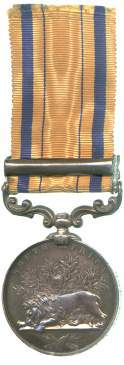Current Location: In storage
Maker(s)
Mint:
London
Artist:
Wyon, Leonard Charles
Artist:
Wyon, William
Ruler:
Victoria (1837-1901)
Ruler:
Victoria regina
(With the title of)
Entities
Categories
Description
The history of the British presence in South Africa is inextricably bound up with that of the Zulu tribes whom it displaced. A series of shaky and short-lived accommodations with the various polities that made up the Zulu kingdoms meant that the border between the two zones was never entirely free from conflict. Between 1877 and 1879 a number of particularly difficult punitive expeditions were mounted by the British authorities, and in 1880 a medal was sanctioned for these that was a new issue of that for the campaigns of 1834-1853 with a slightly modified reverse design.
The bar carried by this medal relates to the endeavours of King Cetshwayo kaMpande, who became King of the Zulus in 1873 but had been their effective ruler since 1856. Although contemporary British accounts paint him as a obstinate and stupid ruler who persisted in boiling and eating missionaries, he was keenly aware of the threat that the British posed to his rule and embarked upon a programme to equip his army with muskets. He incited revolts among other tribes all along the British and Boer borders with the Zulus.
Particularly demanding were the attacks of the Galeka and Gaika tribes on a protected people, the Fingos. The campaigns against the insurgent peoples lasted some eight months from 1877 into 1878 and involved, as well as extensive local forces, contingents of both the British Army and the Royal Navy serving ashore. The conflict, which became known as the Ninth Kaffir War, ended in the annexation of the Transkei, home of the Galeka peoples, to the Cape Colony.
Although such border incidents as these were resolved to temporary British advantage, in 1878 an independent commission appointed to review the border between the British and Zulu territories found many of the Zulu claims to its territory to be justified. This, and Cetshwayo's continued defiance of British demands for reparation for his men's activities, determined the British commissioner in the area, Sir Henry Bartle Frere, to finally reduce the independence of the Zulu kingdom. Accordingly he demanded a complete disarmament on the part of the Zulus and the imposition of a British residency, and when Cetshwayo predictably ignored this demand, invaded Zululand in January 1879.
The Zulu forces outnumbered the British and African troops ranged against them two to one, and on occasions were able to achieve far more effective concentrations that resulted, for example, in a massacre of Europeans at the Battle of Isandlwana. Normally, however, the balance of battle was with the far-better-equipped Imperial troops, and only an acute shortage of troops (worsened by African desertions) as against Cetshwayo's forces prevented a rapid British victory. By March 1879 reinforcement was altering this impasse, and the Battle of Ulundi, in which the Zulus lost 1500 men, more than a tenth of their force, against 100 British losses from a force of more than 5000, determined most of the Zulu chiefs to seek peace. Cetshwayo became a fugitive, and was eventually captured and imprisoned in Cape Town. The British now faced the problem of effectively controlling this huge and resentful territory with the limited forces available to the peacetime administration.
This medal was awarded to Private P. Reddington of the 2nd Battalion, 24th Foot. Lester Watson acquired the medal at some point before 1928.
Notes
History note: Gift of L. Hoyt Watson; ex Lester Watson Collection, acquired before 1928
Legal notes
Given by Lester Watson through Cambridge in America, 2009
Measurements and weight
Diameter: 36.3 mm
Weight: 40.28 g
Acquisition and important dates
Method of acquisition: Given
(2009)
by
Watson, Lester
Dating
1880
-
1881
Materials used in production
Silver
Techniques used in production
Struck
Inscription or legends present
Inscription present: Bust of Victoria facing left
- Text: VICTORIA REGINA
- Location: Obverse
- Type: Design
Inscription present: Lion couchant before protea bush; Zulu shield on four crossed assegais in exergue
- Location: Reverse
- Type: Design
References and bibliographic entries
Identification numbers
Accession number: CM.1439-2009
Primary reference Number: 141533
Watson Catalogue: 351
Ordering: M-0322
Previous object number: LW.0322
Stable URI
Audit data
Created: Saturday 6 August 2011
Updated: Monday 25 March 2024
Last processed: Wednesday 14 May 2025
Associated departments & institutions
Owner or interested party:
The Fitzwilliam Museum
Associated department:
Coins and Medals





